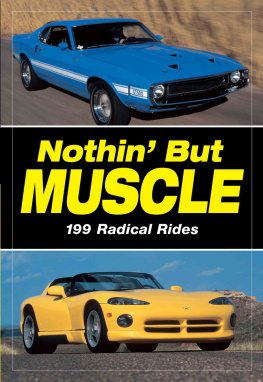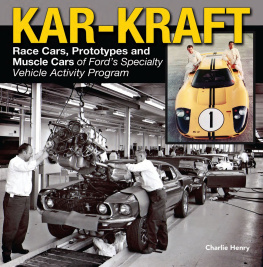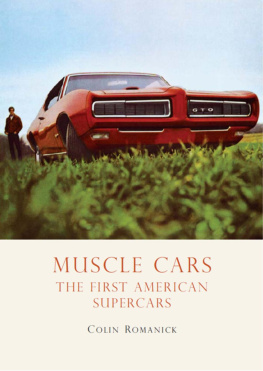Copyright 2010 F+W Media, Inc.
Krause Publications, a division of F+W Media, Inc.
700 East State Street Iola, WI 54990-0001
715-445-2214 888-457-2873
www.krausebooks.com
FOREWORD
By Brian Earnest
TIMELESS MUSCLE
The term muscle car really has no strict definition. Some muscle cars are small, like the Corvettes and AC Cobras. Some are big, like the Buick Gran Sports or Chevy Impala SS's.
Some do the quarter-mile in 11 seconds, some take more like 17. Some are Plain Jane sedans that truly qualify as wolves in sheep's clothing who would ever know by looking at it that an early Chevy 409 Impala could blow the doors off almost anything on the road at the time? On the other hand, there are an equal number of muscle cars that carried all kinds of wild paint jobs, hood scoops and menacing accessories that made them look as fast as they ran. C'mon, has there ever been anything harier-looking than a winged Plymouth Superbird or technicolor Pontiac Judge, with color-coordinated eyebrows over the wheel wells?
In Nothin' But Muscle, we go back and revisit the best of the high-testosterone machines the cars that everybody wanted to drive, and nobody wanted to race against. Not every muscle car made our cut. We stuck to the cars that were the most influential and most memorable. A lot of great cars missed out. We go as far back as the 1950s with some Hudsons and Chevys that were true forerunners of the machines that followed. In the early 1960s, the star performers on the streets and strips of America were the 409 Chevys, 421 Super-Duty Pontiacs, 426 Max Wedge Mopars, and powerhouse 427 Fords.
The 1964 model year brought us the legendary Pontiac GTO, considered by many car buffs to be the first true muscle car a midsize car with a big-block stuffed under the hood.
The late 1960s were clearly the salad days for great muscle machines: big-block Mustangs, Shelbys, Chevelles, Firebirds, Camaros, Chargers, Challengers, Super Bees, AMXs, Gran Sports, 4-4-2s Every automaker seemed to be making cars that could satisfy even the heartiest appettite for horse-power.
The 1970s were the lost years for muscle car fanatics, as the gas crunch and squirrelly insurance companies combined to turn down the music on the hi-po party.
Good things have a way of coming back around, however, and the 1980s rebounded with a new era of 5-liter Mustangs and menacing black Buicks that gave a new generation of horsepower freaks something to lust after.
Since then, we've seen the arrival of the Dodge Vipers, 500-hp Corvettes, new-generation Mustangs and even the return of the Camaro. Sure, these modern wonders are light years ahead of those spartan pavement pounders of the 1960s. Shoot, some of them even get great gas mileage! But for all their differences, really fast, scary, spectacular machines from all eras seem to share a common spirit. Whether you're talking about a 1970 LS6 Chevelle, or a 2006 Z06 Corvette the cars in our list were the gnarliest things around for their time.
It's these Muscle Car Hall of Famers that we celebrate in the pages that follow.
Here's hoping the high-octane gas never stops flowing.
AMC & HUDSON
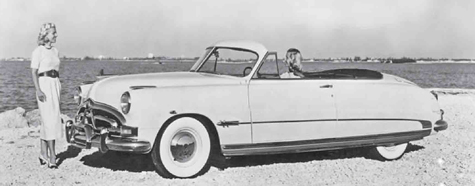
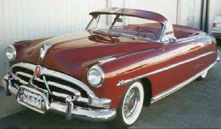
1951-1952 HUDSON HORNET
If there was ever a car that was unlikely to dominate American stock car racing, it was the Step-Down Hudson Hornet. With a 124-inch wheelbase, a 77-inch width and a shipping weight around 3,600 lbs., the Detroit-built Hornet was a big car. Under the hood was an inline, L-head six not a V-8.
The Hornet had made its bow in 1951, the same year that the Chrysler Firepower Hemi V-8 was introduced. Few observers thought that, even with 308 cubic inches, the new Hudson product could ever set the pace in the recently formed sport of stock-car racing.
Marshall Teague, the owner of a garage in Daytona Beach, Florida, saw the Hornet's potential.
He figured out that the car's low center of gravity, its great handling and its big, torquey six were just what was needed to beat the racing-winning Olds 88.
Teague outran the Olds drivers and was then able to get the attention of Hudson's top brass. He convinced management to add heavy-duty parts to their options list. With extras like Twin H carburetion (a setup using two single-barrel carburetors) the Hudsons were virtually unbeatable on the nation's racetracks.
The Hornet got only minor changes in 1952, but by then the roundy-round boys had all they needed to keep the Hudsons out front. A number of top NASCAR drivers switched to the brand and 27 out of 34 Grand National races went to Hudson Hornets that year.
Teague took the checkered flag at Daytona. He then switched to AAA-sanctioned racing up north and won half of the 14 races on the schedule. Other Hudson drivers took five more, giving the nameplate 39 wins in 48 major 1952 events.
Hornets were not low-priced cars. The popular coupe sold for $2,742, the Hollywood two-door hardtop cost $3,095 and the convertible was priced at $3,342.
For those not involved in stock car racing, the Hudsons didn't seem all that fast in straight-line acceleration testing. Motor Trend magazine reported a 0-to-60 time of 16.8 seconds. However, ace automotive writer Tom McCahill tested a Teague-tuned Hornet and found it could achieve the same speed in 12.8 seconds. McCahill recorded a maximum speed of 107 mph, versus Motor Trend's under-100 mph top speed.

Tom Glatch
1954 HUDSON HORNET
The 1954 Hudson Hornets were still the stars of the racing world, but in the end all those checkered flags weren't enough to keep the nameplate alive.
Even with the midyear introduction of the low-priced Hornet Special series, sales did not pick up. In all, 24,833 Hornets were made. Only 11,603 of the smaller Wasps were put together.
The base Hornet engine, still at 308 cubic inches, was rated at 160 hp and the Twin-H option brought that figure to 170 hp for $86 more. However, the stock-car racers used the specially built 7-X engine, which was available through the company's parts operation for $385. This high-performance engine reportedly produced 210 hp.

